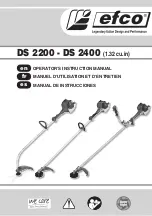
4
5
Fitting the Cutting Wheel
• First lock the tool spindle with the spindle lock key (
M
in
Figure 1
).
• Refer to
Figure 4
: remove the cutting wheel reverse lock screw (
O
) with the 4mm hex key
(
N
in
Figure 1
). Note: this screw has a left-hand thread and is designed to lock the cutting
wheel securing nut (
P
) when the tool is being used in the reverse cutting direction.
• Now remove the cutting wheel securing nut (standard right-hand thread) with the cutting
wheel securing nut key (
L
in
Figure 1
).
• The cutting wheel (
K
) is placed over the location washer (
Q
), then reassemble the securing
nut (
P
) and the reverse lock screw (
O
), making sure that they are tightly secured.
Flexible Head Adjustment
Refer to
Figure 5
: the 3-position flexi-head is quickly adjusted to 25° up or down from the
standard straight position by releasing the securing clamp (
G
in
Figure 1
) and repositioning
the head.
Note
: there are three positions only - 25° up or down from the standard straight position,
and the cutting head will click positively into each of the three positions.
Do not adjust the
cutting head to less than 25°
, as although the securing clamp may be closed, the cutting
head position will slip as the tool is being used, which may result in damage or injury.
When using the tool, take care not to exert excessive force; burning of the work piece or
obvious speed reduction indicates too much force being applied. Start up the tool away from
the work piece and set it down onto the area to be cut steadily and with care. Move in the
direction of the cut. When cutting is finished, lift the tool away from the work piece before
stopping the motor.
Always use the cutting wheel guard, and position it so that the guard faces the operator.
Before using, test the cutting wheel by briefly running under a barrier (under a heavy work
bench for example), to stop any possible broken wheel parts or debris.
Using the Cut Off Tool
Fig 4
K
O
P
Q
25º
<25º
û
ü
Fig 5






















